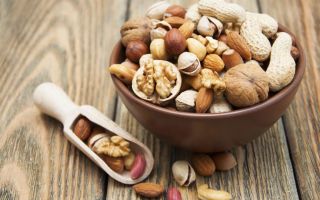Content
Nuts are commonly referred to as edible vegetable fruits, in which the edible part is usually protected by a hard shell. The history of the existence of nuts begins in the distant biblical times. They have long been prized for the presence of fatty oils and their high vegetable protein content. The benefits and harms of nuts depend on the method of use and belonging to a particular species.
Chemical composition of nuts
The health benefits of nuts are associated with moderate intake and consideration of basic qualities. The chemical composition of nuts is characterized by a high content of fats and proteins. The level of fatty oil in each of the varieties exceeds the 50% limit per 100 g. Macadamia has the highest fat content: 73 g.
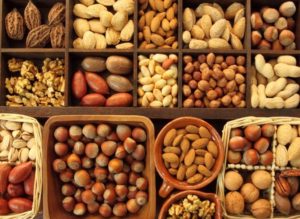
In terms of the presence of protein, the first place is occupied by peanuts, they count up to 27 g. Almonds contain 19 - 20 g of protein, hazelnuts and walnuts - 15 - 16 g.
Among the useful elements there are micro-, macronutrients and vitamins. Nuts tend to have a positive effect on digestive processes due to the fiber they contain. Dietary fiber is present in the range of 3 to 12 g, depending on the type.
How many calories are in nuts
The benefits and harms of nuts for the human body depend on the calorie values.
|
variety |
energy value in kcal |
|
peanut |
564 |
|
almond |
583 |
|
hazelnut |
537 |
|
Walnut |
663 |
|
macadamia |
702 |
|
cashew nuts |
572 |
They talk about the benefits of nuts only if their use is not uncontrolled, but systemic.
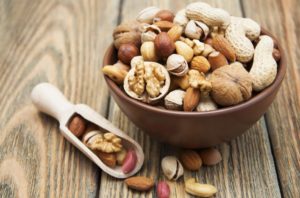
Why nuts are useful for the human body
Numerous studies show that nuts increase lifespan when consumed regularly and in moderation. The low glycemic index promotes the inclusion of fruits in the diet of insulin dependent people. Essential acids improve brain activity, strengthen the heart muscle, and normalize blood circulation.
Types of nuts and their beneficial properties
The nut variety is classified according to its belonging to a particular family.
|
family |
representatives |
|
nut |
walnut, pecan |
|
pink |
almond |
|
sumach |
cashews, pistachio |
|
legumes |
peanut |
|
proteaceous |
macadamia |
The impact on human health is constantly being researched. In the course of studying the properties of each of the species, new facts arise.
Peanut tends to strengthen the nervous system. It is recommended for insomnia, anxiety, and anxiety. The benefits of taking peanuts are enhanced by their ability to be absorbed quickly and easily by the body.
Almond belong to the category of elite nuts, it is often called "royal". The presence of calcium makes it useful for those who need additional strengthening of the musculoskeletal system.The property of improving blood circulation is used to recommend almonds as a prophylactic agent for diseases of the heart and blood vessels.
Hazelnut contains a unique substance - paclitaxel. It prevents cancer cells from dividing. It is also useful to include hazelnuts in the diet for people who have been diagnosed with diabetes or hypertension; it has the property of affecting the state of the circulatory system, reducing cholesterol levels and helping to improve brain activity.
Walnut dominates among the products that have beneficial effects on the activity of the thyroid gland. This is due to its high iodine content. It is also recommended during periods of rehabilitation after illnesses or to increase the body's defenses during periods of cold. The nuclei are useful in the mild course of diseases of the stomach, liver, or kidneys. They are advised to be included in the diet of schoolchildren and students, since they promote the activation of brain activity, therefore they tend to improve the processes of memorizing information.
Macadamia - a champion in the content of unsaturated fatty acids, has a high caloric value. Among the useful properties, the ability to influence cholesterol levels and improve all blood parameters is noted. This becomes possible due to the presence of riboflavin, trace elements, polates and easily digestible protein. The benefits of this type of nuts are confirmed by the fact that it is recommended for the treatment of hypertension.
As part of cashews there is proanthocyanidin from the group of flavonoids. It prevents the development of cancerous tumors. These nuts contain a minimum amount of fat, which is why they are often included in diet menus. Cashews have high levels of folate, which makes them beneficial for pregnant or planning women. Some research suggests that cashews have mild pain relieving and anti-inflammatory properties.
Which nuts are healthier for women
Almonds are considered the most useful for the female body. This is due to the main healing properties of the nut. The content of fiber, vitamin E and protein makes it suitable for inclusion in diet menus and helps women to reduce weight.
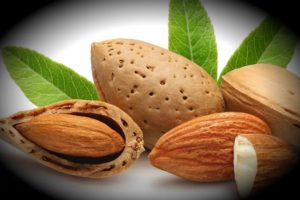
Almonds tend to have a beneficial effect on the appearance of women:
- improves the condition of the upper layers of the skin;
- strengthens the hair structure;
- reduces the risk of developing brittle nails.
The plant components of almonds and hazelnuts have an effect on the female figure. The protein found in nuts is a building block and is beneficial for breast formation or recovery after weight loss and childbirth.
The healthiest nuts for men
Of the variety of varieties, walnut kernels are considered the most useful for men's health.
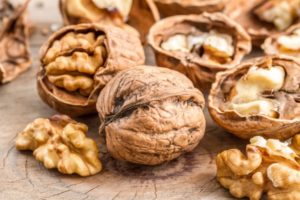
They affect male potency: they normalize the activity of the reproductive system. Their effectiveness has been proven by numerous medical studies, recorded in scientific works around the world. With systematic use, walnut kernels become a means that prevents damage to the prostate gland.
At what age can nuts be given to children
Despite the numerous beneficial properties and the ability to positively influence the body's systems, this product is not recommended for children under 3 years old. This age period is characterized by an insufficient formation of the gastrointestinal tract, therefore, the use of nuts may be harmful, not beneficial.
Do not forget that nuts can trigger allergies. Peanuts are considered the most allergenic product, therefore it is recommended to postpone its introduction until the age of five.
You should not give nuts to children whose menu consists of half of dishes with a puree-like consistency.
The benefits of taking walnuts or almonds every day are especially noticeable in younger students. This period is characterized by increased mental and physical stress, a change in the rhythm of life and types of activity. Almonds or hazelnuts are recommended as a small snack during training.
Can nuts during pregnancy
The benefits and harms of nuts during pregnancy depend on the type of product taken.
Peanut can be harmful as highly allergenic: it can provoke the development of skin rashes in the mother and manifestations of side effects of fetal development.
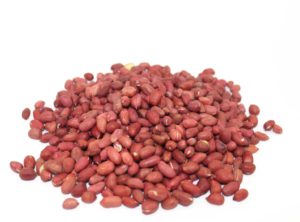
Walnut not recommended for use during the first and last months of pregnancy due to the possible effect on the tone of the uterus. The useful properties of walnut kernels are called the normalization of blood counts, a positive effect on the vessels of the brain.
Hazelnut during pregnancy, take with caution due to the high fat content. A useful property of hazelnuts is considered a positive effect on blood vessels, liver, and musculoskeletal system.
Cashew nuts has a high rate of benefit for a pregnant woman. The substances of the composition tend to normalize the activity of the heart muscle, improve the state of the nervous system. Cashews are beneficial for women who develop anemia, as they contain easily absorbed iron.
Are nuts good for losing weight
Not all nuts are good for weight loss. First of all, take into account the high degree of calorie content. The most optimal option for consumption during dietary unloading is almonds.
The plant stearins contained in it reduce cholesterol and glucose markers. Arginine has the ability to increase the elasticity of blood vessels. The content of dietary fiber helps to normalize metabolic processes. These effects of almond kernels make it possible to use it as an afternoon snack in the diet. It saturates the body, dulls hunger and does not contribute to body fat.
Nutritionists advise avoiding macadamia and walnut kernels when losing weight. Exceeding the intake norms can lead to the fact that the process of getting rid of extra pounds will be stopped and reduced to zero. An unbalanced diet can harm the digestive system.
How many nuts can you eat per day
The health benefits and harms of nuts directly depend on controlling the amount of intake.
Some types are healthier to eat raw, sometimes it is recommended to soak them before eating.
To maximize the benefits, nutritionists have developed guidelines for each type.
Daily rate:
- peanuts - up to 20 pieces;
- almonds - up to 15 pieces;
- hazelnuts - up to 20 pieces;
- walnut kernels - up to 20 pieces;
- macadamia and cashews - 10 each.
How and with what to use nuts
Researchers of useful properties advise to regulate not only the amount of intake, but also to monitor compliance with the rules for preparing nuts. Depending on the type, they are used as a stand-alone snack, added to various dishes, or prepared as the main ingredient.
It is customary to combine all types with dried fruits, cereals, fresh vegetables, fruits.
Almonds are recommended to be soaked before taking. This method increases its beneficial properties, facilitates easy absorption.
The preparation of nut milk is considered especially valuable in nutrition; it is prepared on the basis of any type with the addition of milk of plant origin.
Cashews, almonds, peanuts, walnuts are added to all-season salads.
Walnuts, almonds, macadamia are the main ingredients for making oriental sweets.

Almonds, peanuts, and walnuts are often found as a filling for baked goods or as a sprinkle on a finished dish.
In the United States, it is customary to cook peanut-based pasta, it is considered the national pride of the country, it is used to make sandwiches, desserts, and impregnation.
Nuts are often served for breakfast: the benefits of taking them lie in saturating the body, giving vigor.
Nut treatment
The benefits of different types for treatment are explained by the properties of each of them:
- on the basis of walnut kernels, tinctures are prepared for internal use, as well as ointments for the treatment of skin rashes, wound healing;
- Almonds and hazelnuts can be found in a variety of pharmaceutical products.
All varieties have a low glycemic index. Almonds and walnuts are beneficial as nuts used to treat diabetes. They significantly reduce the concentration of cholesterol in the blood when taken regularly.
Harm of nuts and contraindications for use
The main disadvantage is the high level of allergenicity. Walnuts and peanuts are considered the most allergenic. The harm is directly related to overuse.
- Food overload can be harmful to people diagnosed with kidney or liver disease.
- Due to their high calorie content, they can harm those who are obese and suffer from drops in blood pressure.
- Excessive intake leads to increased activity of the pancreas, this causes an increased production of gastric juice, which is harmful in the form of heartburn or nausea.
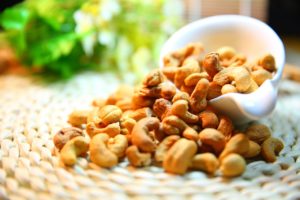
Selection and storage of nuts
When buying any of the types, you should pay attention to external signs:
- no damage;
- core integrity;
- uniform color;
- lack of foreign smell.
So that the kernels do not deteriorate and do not lose their useful properties, they are stored under the condition of darkness and dryness of the room, using glass or tin cans with tightly screwed lids. The maximum shelf life is 6 months.
Conclusion
The benefits and harms of nuts depend on the variety, cooking methods, moderation of intake. It is customary to use them for a long time as a remedy for the treatment of diseases, increasing the tone of the body or for preparing delicious dishes.

